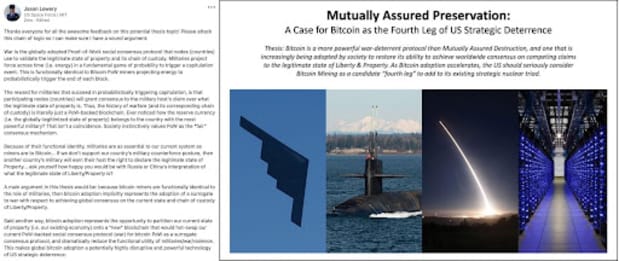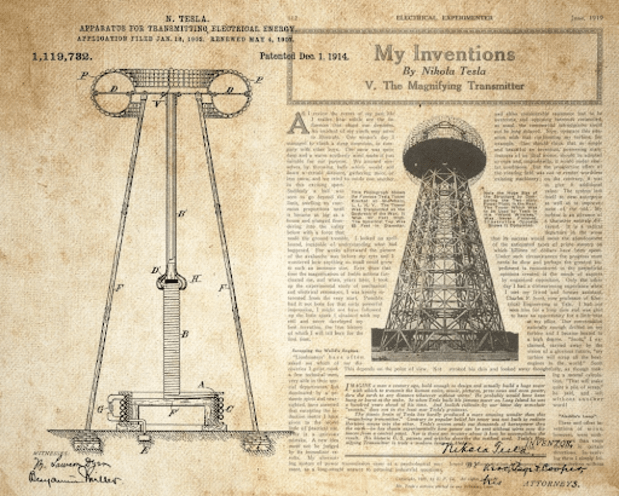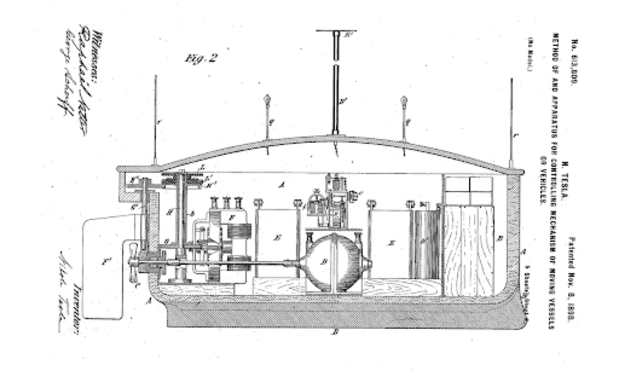As an arbiter of truth for the most reliable and cheapest forms of energy, Bitcoin can enable Nikola Tesla’s vision of a peaceful, abundant energy future.
Many attempts to bring about the permanent end state of war can be found throughout history. “The war to end war,” mutual assured destruction, dynamite and machine guns — each of these failed to end wars, despite optimistic theories that they might.
In 1900, Nikola Tesla proposed revolutionary first principles to end war of his own. His idea was to remove humans from the battlefield altogether. He envisioned intelligent machines, with minds, competing against each other with a “maximum rate of energy-delivery” which would end wars and bloodshed, and bring about global peace.
Today, we have these first principles in Bitcoin mining — expressed by Tesla, in his own words:
“But now, what is the next phase in this evolution? Not peace as yet, by any means. The next change which should naturally follow from modern developments should be the continuous diminution of the number of individuals engaged in battle. The apparatus will be one of specifically great power, but only a few individuals will be required to operate it. This evolution will bring more and more into prominence a machine or mechanism with the fewest individuals as an element of warfare, and the absolutely unavoidable consequence of this will be the abandonment of large, clumsy, slowly moving, and unmanageable units. Greatest possible speed and maximum rate of energy-delivery by the war apparatus will be the main object. The loss of life will become smaller and smaller, and finally, the number of the individuals continuously diminishing, merely machines will meet in a contest without blood-shed, the nations being simply interested, ambitious spectators. When this happy condition is realized, peace will be assured. But, no matter to what degree of perfection rapid-fire guns, high-power cannon, explosive projectiles, torpedo-boats, or other implements of war may be brought, no matter how destructive they may be made, that condition can never be reached through any such development. All such implements require men for their operation; men are indispensable parts of the machinery. Their object is to kill and to destroy. Their power resides in their capacity for doing evil. So long as men meet in battle, there will be bloodshed. Bloodshed will ever keep up barbarous passion. To break this fierce spirit, a radical departure must be made, an entirely new principle must be introduced, something that never existed before in warfare — a principle which will forcibly, unavoidably, turn the battle into a mere spectacle, a play, a contest without loss of blood. To bring on this result men must be dispensed with: machine must fight machine. But how accomplish that which seems impossible? The answer is simple enough: produce a machine capable of acting as though it were part of a human being — no mere mechanical contrivance, comprising levers, screws, wheels, clutches, and nothing more, but a machine embodying a higher principle, which will enable it to perform its duties as though it had intelligence, experience, judgment, a mind! This conclusion is the result of my thoughts and observations which have extended through virtually my whole life, and I shall now briefly describe how I came to accomplish that which at first seemed an unrealizable dream.” –Nikola Tesla, “The Problem Of Increasing Human Energy,” The Century Magazine, 1900
While those first principles aptly describe Bitcoin mining, Tesla didn’t have Bitcoin in mind, of course. He imagined what now reads like a post-steampunk fantasy of massive wireless energy towers that would harness free energy from the Earth and wirelessly power the entire world and power death rays (or “peace rays”) that were so destructive, no army would approach the borders of other countries. It was a mutually-assured destruction no man’s land where Tesla conceptualized “telautomatic” drones that would fight each other, instead of humans. This was how he envisioned a lasting peace.
Tesla envisioned machines of “maximum … energy-delivery,” that were “embodying a higher principle.” Bitcoin can be described similarly. As Robert Breedlove has tweeted, “As a claim on human productivity, money is the highest form of energy mankind can channel.”
In 1919, having seen the ravages of a World War, and his own dreams for world peace dashed, Tesla clarified his prediction:
“War can not be avoided until the physical cause for its recurrence is removed and this, in the last analysis, is the vast extent of the planet on which we live. Only thru annihilation of distance in every respect, as the conveyance of intelligence, transport of passengers and supplies and transmission of energy will conditions be brought about some day, insuring permanency of friendly relations. What we now want most is closer contact and better understanding between individuals and communities all over the earth, and the elimination of that fanatic devotion to exalted ideals of national egoism and pride which is always prone to plunge the world into primeval barbarism and strife. No league or parliamentary act of any kind will ever prevent such a calamity. These are only new devices for putting the weak at the mercy of the strong… Peace can only come as a natural consequence of universal enlightenment and merging of races, and we are still far from this blissful realization.” –Nikola Tesla, “My Inventions,” Electrical Experimenter, 1919
Had Tesla lived to see Bitcoin, he would have seen that it embodied these principles. The internet itself was an idea Tesla had predicted in his 1926 Colliers interview, where he described a wireless web in great detail. He gave details of smartphones that could fit in a vest pocket and allowed communication using voice and video. Tesla predicted wireless newspapers, live streaming and video conferencing. He described the ability to send documents, music and video around the world. He predicted the Internet of Things, self-driving cars, autonomous drones and robots. Interestingly, the U.S. Department of Defense and Defense Advanced Research Projects Agency helped develop the early stages of the internet in the 1960s, as a decentralized network for defense.
Henry Ford, Thomas Edison and Buckminster Fuller each believed it was possible for an energy-backed currency to facilitate the war end state and replace gold. Today, thanks to the efforts of Satoshi Nakamoto and countless others, that ideal is realized in Bitcoin. It’s intriguing to think these inventors were perhaps somewhat inspired by Tesla’s predictions.
There is no doubt that Tesla propelled humanity forward with his inventions. He invented the first alternating current (AC) motor and he developed AC generation and transmission technology, which is still the global standard for power transmission. He invented electric oscillators, meters and the Tesla coil, a high-voltage transformer. He demonstrated radio communication two years before Marconi. He also partnered with General Electric to build the first modern power station by installing AC generators at Niagara Falls.

In 1917, he conceived of a device that would emit exploratory energy waves, enabling operators to establish the precise location of distant enemy craft. The War Department rejected Tesla’s “exploring ray” as unfeasible and a joke. Years later, a new invention using similar technology, helped the Allies win World War II. That technology was radar.
When Tesla died, in 1943, the FBI ordered his belongings to be seized by the Office of Alien Property. John G. Trump (the uncle of Donald J. Trump), who was an MIT professor, electrical engineer and technical aide to the National Defense Research Committee, analyzed all of Tesla’s papers which were retained and remain classified. It’s believed that the government was interested in Tesla’s energy weapons, or at least the theories behind them.
A New Hope: Re-Evaluating Tesla’s Principles
About one month ago, Jason Lowery, a commissioned officer in the U.S. Space Force and a U.S. National Defense fellow enrolled in MIT, proposed a thesis on Bitcoin as the end state of war. He posited that proof-of-work miners are functionally identical to the role of militaries and could be adopted as a surrogate to war with respect to achieving global consensus on the current state and chain of liberty and property.

Lowery joined Twitter and has invited the Bitcoin community to debate and refine his thesis. It more recently became apparent that Lowery’s thesis was based on the same principles that Tesla described of a worldwide competition of “energy-delivery” machines as a peaceful and bloodless surrogate to war. While Tesla was imagining drones and death rays instead of bitcoin miners, the underlying principles of their theses are strikingly similar. No doubt, it will be a fascinating topic of exploration.
Tesla’s Funding Woes
Tesla’s military ambitions made him somewhat of a Tony Stark of the Progressive Era. Though unlike the fictional Stark, Tesla lacked funding to bring his ideas to fruition. Tesla’s grand vision was to bring wireless “free energy” to the entire planet as part of his World Wireless System, which would pull energy from the surrounding environment and make it available to all electronic devices, without the need for wires or fossil fuels.
In 1901, Tesla received $150,000 from J.P. Morgan to build what was advertised as a communications radio transmitter — the Wardenclyffe Tower. The deal gave Morgan a 51% interest in the company as well as a 51% share in present and future wireless patents developed from the project. Morgan was led to believe that he would be able to have a monopoly on transatlantic radio communications.

Over the next few years, Tesla would find himself needing additional funding. However, Morgan stopped funding the project upon learning that the real purpose was not to just send radio signals but the wireless transmission of so-called free energy to any point on the planet.
Because Tesla effectively had to ask permission from wealthy investors, who rarely had his best interest in mind, he could not raise the money he needed unless his work directly benefited those investors. This meant that his vision to bring free energy to the world would always be corrupted by this arrangement — even if his ideas were actually feasible. Today, modern scientists dispute Tesla’s theories on harvesting free energy. To the best of our knowledge of science, they would not have worked. However the point remains that he wasn’t given a fair shot to fully experiment and prove his theories.
If Bitcoin had existed in Tesla’s time, it would have removed the need for a corrupted monetary arrangement. Bitcoin mining is a permissionless and censor-resistant reward mechanism that incentivizes the cheapest and most reliable sources of energy. Tesla could have, hypothetically, self-funded his experimentation with mining rewards. The more successful and efficient his prototypes were, the more successful his mining would become, and the more funding he would secure to scale up his operation.
Bitcoin As A Truth Machine
Bitcoin has been described as a “truth machine” in terms of an incorruptible and immutable financial ledger that eliminates fraud. But, it’s also a truth machine to prove emerging energy technologies and how efficient and reliable they are, without bias or prejudice.
Bitcoin is a physics-based truth machine that pulls humanity forward, by removing bureaucracy and protectionism from the scientific process, while also allowing for failures and creative destruction. It pushes humanity up the Kardashev scale — a measurement of a civilization’s advancement by the amount of energy it can harness, proposed by Soviet astronomer Nikolai Kardashev, in 1964. Bitcoin incentivizes the production of massive amounts of the cheapest energy which could, in turn, foster the end state of war and post-scarcity.
With Bitcoin, we don’t have to trust an engineer making extraordinary claims or dogmatically defend our potentially flawed understanding of physics. Instead, mining rigs can be plugged directly into any energy experiment. Bitcoin doesn’t care what energy source is behind the plug. If that experiment somehow discovers an advancement in energy production, the creator will quickly be rewarded, proven on a public ledger, and soon have the funding needed to scale up the operation. If not, the experiment fails with no reward. Bitcoin miners are mobile, available for hire, can plug into any power source, in any remote location, in portable containers, ready to pay for that energy with cash.
WTF Happened To Physics In 1971
Arthur C. Clarke famously said, “Any sufficiently advanced technology is indistinguishable from magic.” Tesla was often popularly regarded as a kind of magician and pushed the human race forward by having the courage to think differently about the world. The problem humanity now faces is that we’ve not had any of that magic, in physics, since the U.S. went off the gold standard in 1971.
Eric Weinstein is one of many voices raising awareness to the fact that science has stopped working since the 1970s.
Weinstein does not see this as a pure monetary phenomenon. Rather, he believes it is an issue with bureaucracy, red tape, protectionism and transparency. He believes that physicists need to be left alone with a “slush fund” from the government to do their experimentation work.
While Weinstein may not see Bitcoin as a solution, Bitcoin can offer something that the government and academia cannot. Bitcoin is a global test lab for energy experimentation — with an open competition every ten minutes, on the blockchain. It is an arbiter of truth for the most reliable and cheapest forms of energy. It is a public-run energy fund that automatically doles out grants for energy discoveries and discards fraudsters who try to counterfeit work — refining our understanding of what is viable and what is not while pushing us up the Kardashev scale in the process. Teams can create the power generators of the future and call up miners to test them out — splitting the profits and scaling up operations. Failures are discarded with the catastrophic creative destruction we desperately need to flush out bad ideas.
Bitcoin As First Contact
Not only can Bitcoin act as a local truth machine for experimentation, it can in theory act as a truth machine for interstellar civilizations. Dhruv Bansal has posited in his “Bitcoin Astronomy” series that Bitcoin could be used as a “lingua francas” — a universal language distant civilizations could use to truthfully determine how advanced our energy production is and if we would be a worthy trading partner.
And therein lies the power of Bitcoin, a local and universal truth machine for money, finance and energy. A universal and permissionless energy lab powerful enough to prove our advancements in energy to our fellow global citizens and distant civilizations.
Even if Tesla’s dream of “free energy” is impossible, Bitcoin would still act as the arbiter of truth in finding humanity’s cheapest and most reliable energy, through the free market. No other technology can do this. Like Tesla’s vision of a no man’s land battlefield, Bitcoin takes this capitalist energy battle away from fallible humans and into cyberspace. Even if we fail as a species, hypothetical alien archaeologists could piece together how far we climbed the Kardashev scale, by analyzing a recovered full node. Bitcoin is a rabbit hole of immutable truth.
An Abundant And Sustainable Future
Tesla was keenly aware of the toll that carbon-intensive fuels, such as coal, took on the environment. He also understood the importance of considering second- and third-order net effects when it came to weighing a technology’s net benefits to society. He saw how something like iron could be used to build magnificent skyscrapers as well as destructive military vessels.
His 1900 essay, “The Problem Of Increasing Human Energy,” described how humanity could achieve worldwide peace, prosperity and sustainability, not through degrowth, but through abundant and unfettered energy production in concert with, and harvested from, the Earth and the universe itself.
Tesla would have loved Bitcoin for its properties and its incentive structure. It would have afforded him financial freedom, allowing him to experiment without being beholden to conflicted benefactors. It would have created a virtual space for projecting the machine-based energy battle that he envisioned, without the need for human bloodshed. And it would have provided scientific freedom as an open test lab for free experimentation, creative destruction, competition and reward for provable work — proof of work on the world’s most decentralized blockchain as an unforgeable proving ground for experimentation in thermodynamics and next-generation energy production.
Tesla was too early for Bitcoin, but the next generation of experimentalists can harness the power of Bitcoin to reinvigorate our chance of bringing about a brighter, more peaceful and more abundant future. If sustainable energy abundance is at all in the realm of possibilities, Bitcoin might just help us transform that advanced technology from magic into reality. Bitcoin embodies our collective hope for that vision as we begin the journey to realize Tesla’s dreams for the world and humanity.
This is a guest post by Level39. Opinions expressed are entirely their own and do not necessarily reflect those of BTC Inc or Bitcoin Magazine.





















